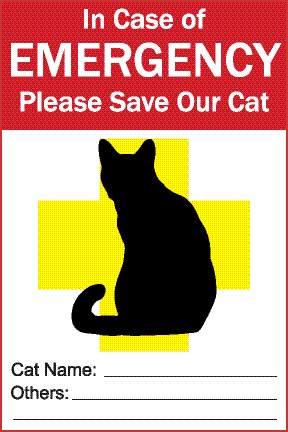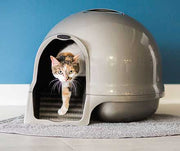Fire Safety for Cats

According to the American Veterinary Medical Association, roughly 40,000 pets die in house fires each year, with about 500,000 pets affected overall. Even worse, about 1,000 of these fires are inadvertently caused by pets themselves.
If you don't already have a fire safety and evacuation plan in place, now is the time to start one. It's very important to make sure that all family members in the household are included in the plan, cats included.
Dogs, especially larger breeds, tend to be easier to find in chaotic situations. Cats, however, are uniquely different to include in emergency plans due to their behavior. As a cat owner, you're likely aware that cats commonly run and hide in safe places when they're afraid. Due to this tendency, grabbing your cat and rushing out of a burning house in the midst of a fire is easier said than done.
The nature of cats must be taken into consideration when crafting your evacuation plan. Below we've outlined a few basic tips to ensure you and your cats are prepared for a fire as much as possible.
A Brief Overview of Fire Prevention
The best fire safety plan is one that prevents fires from starting at all.
1. Make sure you have at least one smoke detector for every floor of your house, and in any bedroom. Batteries should be replaced at least twice a year or every six months. Regularly check your smoke detector for any buildup of dust or debris.
2. You should have multiple fire extinguishers in the home at all times. At the very minimum, you should have one in the kitchen, one in the garage, and one in the laundry room or area. If your home has a fireplace, you should keep an extinguisher close by as well.
3. Always supervise your cats around open flames, including candles.
4. Practice proper electrical safety by ensuring there are no loose cords within your cat's reach. While the risk of chewing through electrical cords isn't as much of an issue with cats as it is with dogs, securing electrical cords promotes a safer environment for everyone, yourself included.
Do Cats Know to Stay Away From Fire?
Although cats are notoriously curious creatures, cats generally know to stay away from open flames. They are aware of certain levels of danger, especially if the fire emits sparks and embers. If you light candles or have a fireplace in your home, your cat may approach the slight flicker of the flames out of curiosity or to warm up in colder weather. As stated above, you should never let your cat remain unsupervised near open flames.
How to Prepare for a Fire Emergency
Below are some simple steps you can take to ensure you've got everything you need for a quick and safe evacuation with your cat.

Display a Pet Alert Sticker
Purchase a pet alert sticker or make a sign to display in plain view near the main entry point of your home. Also, list how many cats are in the house. If possible, be sure to include where they're likely to be found, so first responders know where to look in the event that you're not home. Make sure that every member of the household takes note of common areas of the house that your cat likes to escape to.
Get Your Cat Used to Their Carrier
All cats are different, and some are more skittish than others. Attempting to shove your cat into a carrier for the first time during an emergency is a recipe for (even more) disaster. Take the time to brush up on tips to make your cat carrier more inviting.
Make Sure Your Cat's ID Is Up To Date
Your cat should be wearing a collar with tags containing your most up-to-date contact information in the event that they get loose or separated during the evacuation. If you haven't already, you might want to consider microchipping your cat.
Pack an Emergency Kit
The last thing you want to be doing in an emergency is shuffling around in a panic, trying to gather all of your emergency supplies. Save time (and possibly lives) by preparing your emergency kit beforehand.
Your emergency kit might include:
- A dedicated cat carrier just for emergencies that is always securely stored in an easy-to-reach place.
- Any necessary medications.
- Copies of vaccination records and/or medical history.
In the Event of a Fire
If a fire emergency does happen, act fast. Try to grab your cat and exit the house as quickly as possible. If you are unable to locate your cat, leave, as heartbreakingly difficult as it may be. Never endanger yourself or others by going back inside to look for a pet. Get yourself to safety first and notify emergency personnel as soon as they arrive.
Conclusion
As always, we never expect fires to happen. It's always best to stay prepared for the worst. By creating a fire safety plan for you and your family, chances of survival and getting everyone to safety skyrockets. Be sure to plan for the cats as well by getting your cat accustomed to their kennel and having an evacuation plan in place. Most of the time, cats will find their own way to escape fires, so be sure to microchip your cat and keep their ID tag's up-to-date.
Previous article

Next article

Related posts
View all-

Wet Vs. Dry Cat Food: Which is Better?
As a caring cat owner, you always want the best for your furry friend, especially with their food. You typically have two choices: dry cat food in a bag or canned wet food. Whether you've just brought home a new kitty or are looking to transition to a new food, the decision process can be overwhelming, and understanding the impact of each on your cat's diet is essential. Read Article -

Celebrate National Pet Week: Fun Ideas to Celebrate with Your Pet
National Pet Week is right around the corner, so it's time to plan how you're going to celebrate! While we're sure you celebrate your pet all day every day... Read Article -

5 Simple Tips to Make Sure Your Cat Drinks Enough Water
Ensuring your cat stays hydrated is important, but it can be challenging since many cats don't drink enough water. Dehydration can lead to kidney disease and other health issues. Fortunately, you can encourage your cat to drink more with a few simple changes. Read Article



